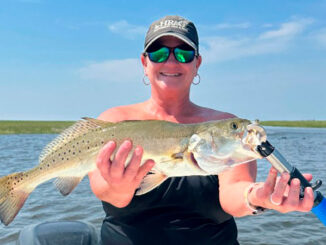
While trolling can seem monotonous, it’s just as important to stay alert with this fishing technique as with others, Harold Schoeffler cautioned.
The angler remains on constant alert for feeding slicks, those patches of slick water that look as if oil has been poured on them. And oil is indeed what causes them — the oil released from bait species’ bodies by attacking speckled trout.
“I don’t just look for any slick,” Schoeffler growled. “Real big slicks are not feeding fish. Fish make slicks 50 to 100 feet across.”
He pays attention to wind and currents when he finds a slick. Because those factors might have moved the slick off the feeding school, Schoeffler aims to troll upcurrent or upwind through the slick and beyond.
Her also wants to know what’s on the bottom. But no fancy electronics for him: Because trolling is most effective over large open oyster or shell reefs, he manually probes the bottom with a stout bamboo pole he keeps stowed near the control box on the boat’s gunnel.
“You can go to court with a pole,” the expert litigator said with a chuckle, “but not with an electronic instrument. The minute you bring in an instrument, they question you about calibration and such.”


